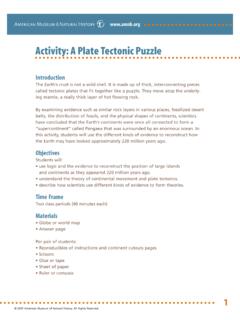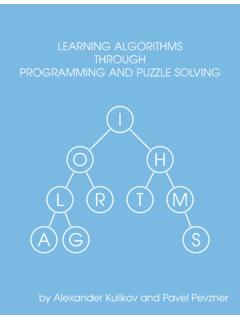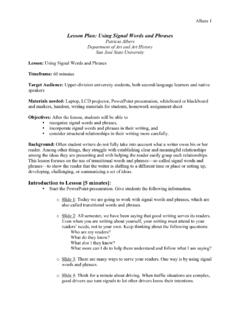Transcription of SOLVING A SUMOKU PUZZLE - Kappa Puzzles
1 1217166591131181313691712131683910166813 121511513911139513118 SOLVING A SUMOKU PUZZLEWe ve had tons of requests for help in getting started onSumoku Puzzles . There really are a wide variety of strategiesfor these challenging Puzzles , and we thought the best wayto describe some of those strategies was to actually workthrough a PUZZLE from start to finish. As we solve, it might behandy for you to fill numbers into the current diagram inpencil. The first thing to think about are the ways thatnumbers can be partitioned as the sum of two othernumbers. For example, on one extreme, a sum of 3 can onlybe broken down one way (1+2), while at the other extreme,10 can be partitioned four ways using the digits 1 to 9 (1+9,2+8, 3+7, and 4+6).
2 People who solve many Sumokupuzzles become very familiar with the various s a list:3 = 1+24 = 1+35 = 1+4, 2+36 = 1+5, 2+47 = 1+6, 2+5, 3+48 = 1+7, 2+6, 3+59 = 1+8, 2+7, 3+6, 4+510 = 1+9, 2+8, 3+7, 4+617 = 8+916 = 7+915 = 6+9, 7+814 = 5+9, 6+813 = 4+9, 5+8, 6+712 = 3+9, 4+8, 5+711 = 2+9, 3+8, 4+7, 5+61217166591131181313691712131683910166 8131215115139111395131187|97|91|21|27|97 |98|98|91|21|27|97|98|98|9In this second diagram, I ve "penciled in" all pairs that canonly go one way. Notice that we haven t quite determined thefinal numbers that go in the slots, but we ve narrowed eachdown to just two numbers. Look at the 8|9 pair in the firstrow.
3 Since no digit appears more than once in a row orcolumn, no other slot in the first row can be an 8 or a , we know that the fourth slot of the first row is a 7 ratherthan a 9, and the fourth slot of the second row is a 9. If youlook in the eighth column, you can likewise see that the thirdslot down in the eighth column is an 8 rather than a 9, and itspartner at the end of the third row is a 9. Staying in the thirdrow, let s consider how we can get a sum of 13. It s not 4 and9 or 5 and 8, since 8 and 9 are already taken, so it has to be6 and 7. Since we already have a 7 in the fourth column, thethird number of the fourth column is a 6, and its partner in thethird column is a 7.
4 We now have 6 through 9 determined forthe third row. By elimination on possible partitions of 9, thesixth and seventh number in the third row are 4 and 5, insome order. The first slot in the third row isn t 1 or 2, since 1and 2 are already in its column. By elimination, that slot holdsa 3. Its partner in the first column is a 5. Look at the 12-box inthe first column. It can t hold 3 and 9 or 5 and 7, since 3 and5 are taken, so it holds 4 and 8. The top number isn t an 8(see above), so it s a 4 and its partner is the 8. The 7 in the first column isn t in the 15-box, since 8 is alreadyused. Thus, 7 is in the bottom slot of that column.
5 Thesecond slot in the bottom row is a 6. The only numbers in thethird row that we ve yet to place are the 1 and 2. If the fifthslot in the third row were the 1, then number below it wouldbe 5. Since there s already a 5 in the fourth row, that can tbe. Thus, the fifth slot in the third row is a 2, and a 4 is belowit. By elimination in the third row, the second slot holds the means the second slot in the second column holds a 2,and its partner in the 3-box is a 1. There s another 6-box inthe fifth column. It can t hold 2 and 4, so it holds 1 and 5, insome order. The 1 can t be in the second slot, so the 5 is,and the 1 is in the top slot.
6 The third diagram shows our long overdo update. See if youunderstand how everything has been filled |54|5677|97|91|21|27|97|99812978|98|92 Print-at-Home Sumoku1217166591131181313691712131683910 1668131215115139111395131183263151142678 45354677|97|91|21|2799812978|98|9 Just for a change of pace, I m going to switch SOLVING strategies for a minute. Look at the first column. It includesall of the digits 1 to 9, so the sum of the numbers in the first column is 1+2+3+4+5+6+7+8+9 = 45. There are fourvertically oriented boxes in that column; a 12-box, an 8-box, a 3-box, and a 15-box. The sum of these numbers is(12+8+3+15 =) 38.
7 That means that the one number not in a vertical box is (45-38 =) 7. We already discoveredthat fact, but we could have known it right from the start. Now let s use the same idea to find a number we didn talready know. Follow the thin line that separates the seventh column from the eighth column. Notice that itdoesn t cross any boxes until it gets to the last row. The complete boxes in the eighth and ninth columns havesum numbers of 11, 11, 17, 8, 16, 6, 9, and 5 for a total of 83. The only slots we haven t counted from the eighthand ninth columns are the last two slots in the ninth row that are part of a box with a sum of 8.
8 Now, we knowthat the sum of the numbers in each column is 45, so the sum for the last two columns is 45+45 = 90. We sawthat the complete boxes summed to 83, so the incomplete part must total 90-83 = 7. That is, the last two slots inthe last row sum to 7. Therefore, the seventh number in the last row is 1. Wow! We re going to use the idea again in the seventh column. There are three vertical boxes there: a 9-box, a 10-box,and a 13-box. That makes 32 in those six slots. We have a 1 at the bottom, so the seven slots total 33. Thatleaves 45-33 = 12 for the two remaining slots. We saw before that one of them was 4 or 5 and the other was 7 or9.
9 The only way they add up to 12 is if the first is 5 and the second is 7. Their partners in the sixth column are 4and 9, respectively. We ll do this one more time for the sixth column. The vertical boxes are marked with sums of5, 12, and 9 for a total of 26. we have 4 and 9 in the third and fourth slots, which brings our column total to , the fifth slot in the column is 45-39 = 6. The fifth number in the fifth column must then be a 3. Since wealready have the 4 in the sixth column, the 5-box at the top of the column must hold 2 and 3. We have the 2 inthe second row, so the the bottom of the 5-box holds the 3, and the top holds the 2.
10 Time to update the diagram. Things are going to move along quickly from here, and I llforgo some unnecessary explanations. Since we know the 8in the first row is in the second or third slot, the 3 in the firstrow isn t in the 11-box in that row; it s in the seventh slot. Thenumber below it is a 6. The 1 in the sixth column isn t in the12-box nor is it in the bottom row, so it s in the eighth it is the 8. The horizontal boxes in the last row hold 13,11, and 8 for a total of 32. The 8 in the sixth slot makes 40,so the third slot holds the 5. The number above it is the 6 in the first column must by elimination be in theseventh slot.







